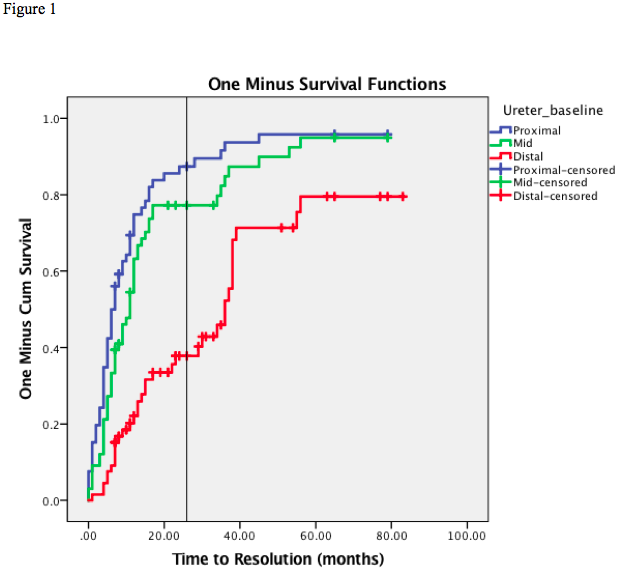Pattern of Improvement of Ureteral Dilatation In Children With Megaureter: Testing The Top Down Hypothesis
Mandy Rickard, MN, NP1, Armando J. Lorenzo, MD2, Adriana Dekirmendjian, BHSc1, Natasha Brownrigg, MN, NP1, Jorge DeMaria, MD1, Deion D'Souza, BHSc3, Caraline McDiarmid, BHSc3, Luis Braga, MD1.
1McMaster University, Hamilton, ON, Canada, 2The Hospital for Sick Children, Toronto, ON, Canada, 3Clinical Urology Research Enterprise- McMaster Children's Hospital, Hamilton, ON, Canada.
Introduction:
Time to spontaneous resolution of hydronephrosis (HN) and hydroureteronephrosis has been well documented in the literature, however, the order in which the ureteric segments resolve has not been clearly defined. Herein, we evaluate a population of children with non-refluxing primary megaureter (NRPM) to determine the order in which the ureteral dilation improves. We hypothesized that the NPRM resolves from the top down; initially with resolution of the proximal, followed by mid and distal ureter dilation.
Methods
We reviewed our prospectively-collected prenatal HN database of patients 0-24 months from 2008-16, selecting those with NRPM (n=92). We excluded patients who underwent surgery to address obstruction (n=20), children with less than 6 months follow up (n=2) and those who did not have a voiding cystourethrogram (n=4) for a total of 66 children. Images were then segregated into 198 ureteric segments (proximal/mid/distal). We defined resolution as APD <10mm or ureteric dilatation <7mm. Descriptive statistics, including frequencies and medians (with min-max) were calculated as appropriate. Kaplan Meier curves were created for time to resolution analyses.
Results
Of 66 patients and 198 ureteral segments, median age at presentation was 2 months (0-23), 83% were male, 33% of which were circumcised. Mean APD at baseline was 11+4 mm and the majority had high grade (SFU III/IV) HN (79%). Median dilatation of ureteral segments (mm) at baseline were 7 (7-16) (proximal), 8 (7-20) (mid) and 11 (7-22) (distal). By a median follow up time of 26 months, 55/66 (83%) proximal ureteric segments, 48 (72%) mid and 22 (33%) distal resolved. Resolution of the HN according to SFU (0-2) or APD (<10mm) criteria occurred in 76% of patients. The rate of proximal ureter resolution was similar to mid (83% vs. 72%; p=0.20), however the rate of resolution for proximal vs. distal (83% vs. 33%) and mid vs. distal (72% vs. 33%) was significantly different (p<0.01). Overall, the rate and time of resolution for each ureteric segment was as follows: 89% of proximal resolved at a median time of 6 (0-79) months, 83% of mid in 9 (0-79) months and 50% of distal in 20 (1-83) months. (Figure 1). Median time to resolution for SFU (0-2) and APD <10mm (months) was 12 (0-79) and 8 (0-83) respectively.
Conclusion
As hypothesized, our data suggest that spontaneous resolution of NRPM follows a top down progression. Distal ureteric dilatation takes up to 10 months longer to resolve compared to proximal and mid ureteric segments, as well as renal pelvis.
Back to 2017 Program
